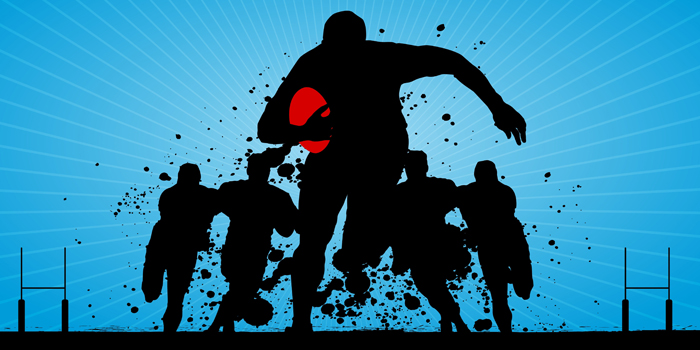
In this article, I want to lay out my proposed plan for an entire off-season for a team in the MLR that failed to make the playoffs. I think you can use a similar format for any competition that you are preparing for. The only caveat for this would be to alter the lengths of each block and, in some instances, leave out blocks if you are time restrained.
I believe that players only need a two-week break from training at the end of a season. I have come to this conclusion experientially due to the number of requests I have received over the last 30 years for programming assistance from my players after about two weeks of the final game they play. Two weeks is enough physical rest unless you have specific injuries that you need more time to gain complete recovery from. I think the major rest period required is from rugby itself. In my case, getting away from the mental and tactical side of the game allows for an excellent psychological rest, and this, I believe, is at least four to six weeks.
Here is my timeline for training blocks and the content priorities of each block of training. I will elaborate as we move through the article.
Key Dates
July 15: Last Game
July 16 – August 1: REST 2 weeks
August 2 – September 5 Phase I 5 weeks
September 6 – September 12 ACTIVE REST 1 week
September 13 – October 16 Phase II 5 weeks
October 17 – October 24 ACTIVE REST 1 week
October 25 – November 28 Phase III 5 weeks
November 29 – December 5 ACTIVE REST 1 week
December 6 – December 24 Phase IV 3 weeks
December 25 – January 2 ACTIVE REST 1 week
January 3 Start of Pre-Season
Phase I
Focus: Size & Strength + Off Feet Conditioning
Phase II
Focus: Strength & Size + Aerobic running
Phase III
Focus: Power & Strength + Size top ups + Speed + Aerobic/Anaerobic running
Phase IV
Focus: Power & Strength + Speed & Metabolic Specific running + Contact Prep
I have focused purely on the strength and conditioning elements of the program, but I think that a skills program to accompany the physical preparation is essential to develop the complete athlete in readiness for how the coach wants to play the game next season.
Phase I
August 2 – September 5 (5 weeks)
Focus: Size & Strength + Off Feet Conditioning
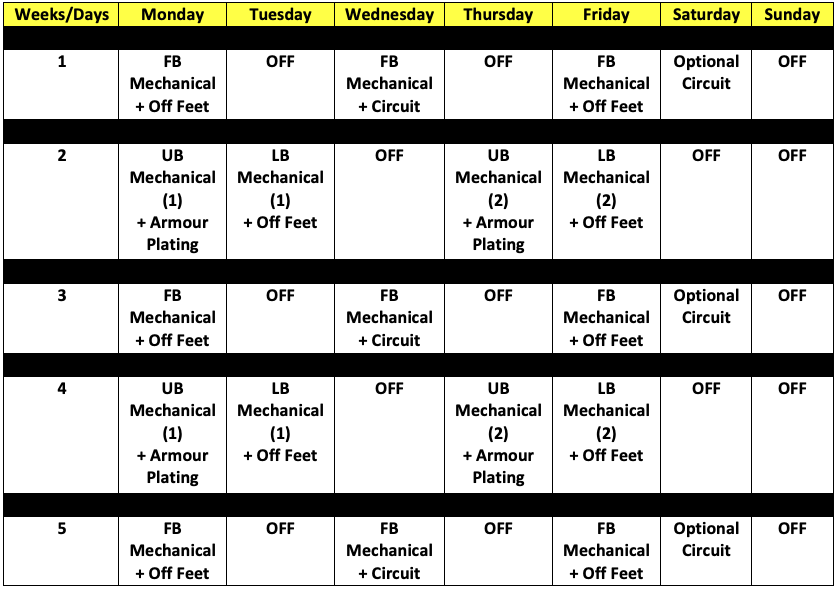
In this first block, the priority is improvements in size and strength, keeping body composition in check, and starting aerobic development via off-feet conditioning using rowers, ski ergs, Assault or Watt bikes, and other accessible cardio equipment. Circuits are a vital element of this stage of the training year to increase the volume of the training and start the elements of resilience and mental toughness. I have also undulated the week loads and contents to add variety to the programming to keep players focused on the specific task at hand in this training block.
All the programming terminology and examples can be found on my seasonal training chart here.
Here are the specific gym programs that I have used in this block. Exercise selection is primarily up to the player to consult with the coach, depending on their training age and injury history.
FB Mechanical
1 x Squat (knee dominant) choose a unilateral movement if the next movement is bilateral
1 x Hinge (hip dominant) choose a unilateral movement if the previous movement was bilateral
1 x Upper Body Push (horizontal or vertical plane)
1 x Upper Body Pull (horizontal or vertical plane)
1 x Loaded Carry + CARE (5)
UB Mechanical (1)
1 x Upper Body Push (horizontal)
1 x Upper Body Pull (horizontal)
1 x Upper Body Push (vertical)
1 x Upper Body Pull (vertical)
Armour Plating - Chest super set Back + UB CARE (5)
UB Mechanical (2)
1 x Upper Body Push (vertical)
1 x Upper Body Pull (vertical)
1 x Upper Body Push (horizontal)
1 x Upper Body Pull (horizontal)
Armour Plating - Shoulders & Arms + UB CARE (5)
LB Mechanical (1)
1 x Hinge dominant (bilateral)
1 x Knee & Hinge superset (unilateral)
1 x Hamstring Specific
1 x Loaded Carry or LB Armour Plating + LB CARE (5)
LB Mechanical (2)
1 x Knee dominant (bilateral)
1 x Knee & Hinge superset (unilateral)
1 x Hamstring Specific
1 x Loaded Carry or LB Armour Plating + LB CARE (5)
I have a selection of body part finisher charts available for players to choose from, or we can determine a specific session on the day. The other key to these programs is the adherence to the CARE program, which is an acronym for Core Accessory Rehab Exercise. I want each player to choose from the chart movements for areas of the body that are more prone to injury in their particular position or where they have had an injury previously. For all loaded carry work, I refer to the chart developed by Thibaudeau for specific distances related to specific characteristics that are in development.
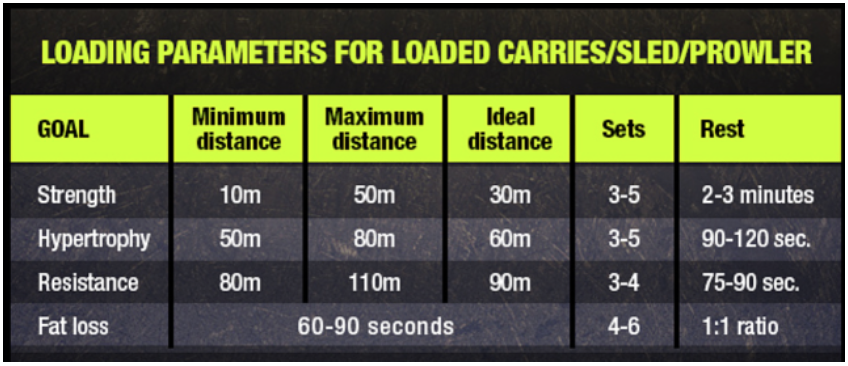
Regarding sets and reps, I follow an undulating pattern of intensity and volume over the course of the duration of the block as shown below.
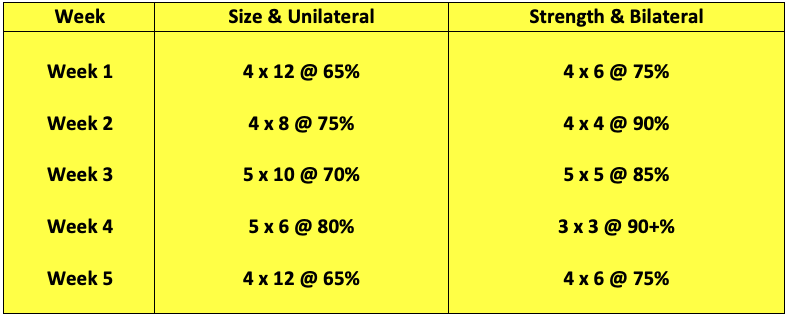
In Phase II of the off-season plan, it's time to start adding in some more explosive training options for the players and move from only off feet metabolic training to re-introduce running of a predominantly aerobic nature. I would add here that if you have a group of players to train with, then you can potentially add some conditioning games to the run mix as well. Games not only add to the intensity of the training but adds enjoyment and specific skills to the mixed metabolic training focus.
Phase II
September 6 – October 10 (5 weeks)
Focus: Strength & Size + Aerobic running
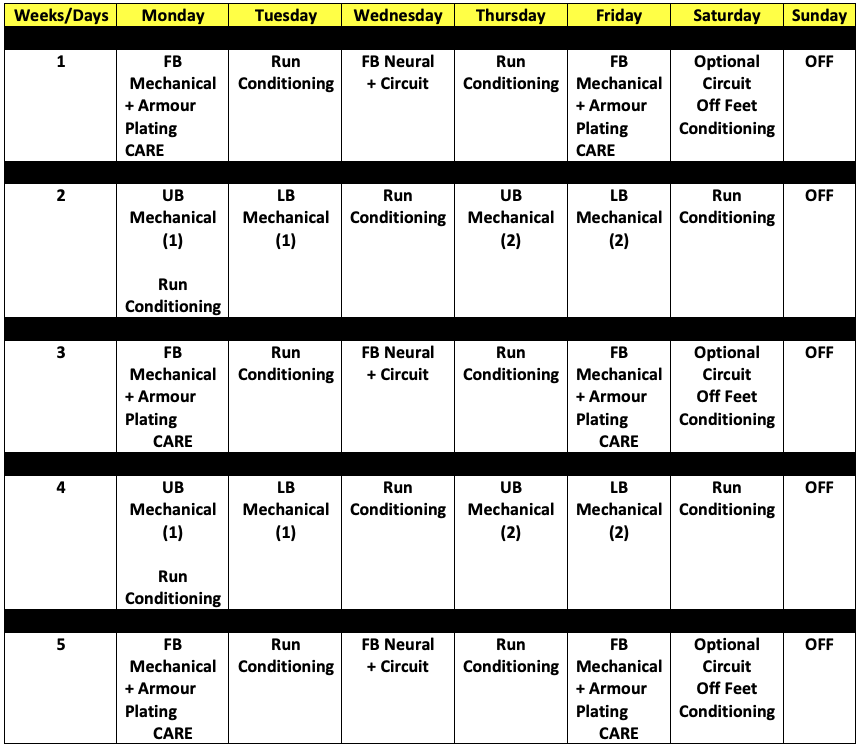
Follow the same details for the Mechanical programming and the circuits from Phase 1 and add a FB Neural as indicated:
FB Neural
1 x Explosive Hip Dominant s/s LB Plyometric or MB Throw
1 x Explosive Knee Dominant s/s LB Plyometric or MB Throw
1 x Explosive Upper Body Push s/s UB Plyometric or MB Push
Week 1: 4 x 6 s/s 4 x 12
Week 3: 4 x 4 s/s 4 x 8
Week 5: 4 x 6 s/s 4 x 12
This table is taken from my seasonal chart and outlines the most commonly used movements that I program specific elements. For sets and reps, I will adhere to the undulating format as outlined in Phase I.
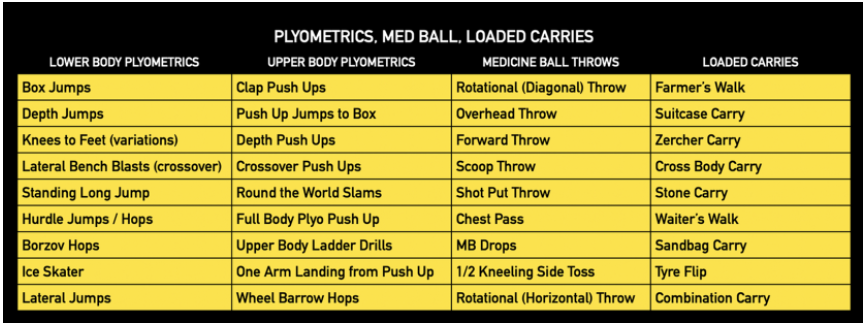
Run Conditioning
Week 1
Session 1
- Tempo Running – 3 x 10 x 100m (try line to try line down the touch line) in 20 seconds walk the try line to far corner in 40 seconds, 10 reps makes a set, 5 minute walk between sets as active recovery
Session 2
- EuroFit 15:15, 78 metres (15 seconds work:15 seconds rest), 2 x 8 reps 2 minute walk between sets
- Double Bronco Reps, 2 reps of the Bronco in < 2:15 every 3 minutes, 2 x 3 reps (1 rep = 2 consecutive bronco reps), 4 minute walk between sets
Week 2
Session 1
- Full Bronco
- 2.4km or 3km time trial
Session 2
- Bronco Ladder
- 1 rep in 0:50, rest 30 seconds
- 2 reps in 1:55, rest 60 seconds
- 3 reps in 3:00, rest 90 seconds
- 3 reps in 3:10, rest 90 seconds
- 2 reps in 2:05, rest 60 seconds
- 1 reps in 0:55 FINISH
2. VO2 grids (20”:20”), 2 x 3 minutes, 70-80m x 40-50m, each side of the rectangle in 20 seconds, 1.5 minutes rest between sets
Session 3
- 200/100 drill x 4
- 200m in < 40 seconds, rest 20 seconds
- 100m in < 20 seconds, rest 40 seconds
2. Coat Hanger + Half Gasser x 4
A: Start at the junction of the halfway line and the sideline, sprint around goal post to far goalposts around the post and back to the start in < 45 seconds (1:1)
B: Start on the ground behind the sideline, get up and sprint to far sideline, go past it and do a down and up then sprint back to start in < 30 seconds (1:1)
Week 3 & 5
- Specific Run sessions select from the drill sheet and accumulate 3 – 4km per session total
Week 4
- Extended Run sessions select from drill sheet and accumulate 5 – 6km per session total
There is a link to my Specific and Extended running sheets at the end of this article.
Phase III
October 25 – November 28 (5 week)
Focus: Power & Strength + Size top ups + Speed + Aerobic/Anaerobic running
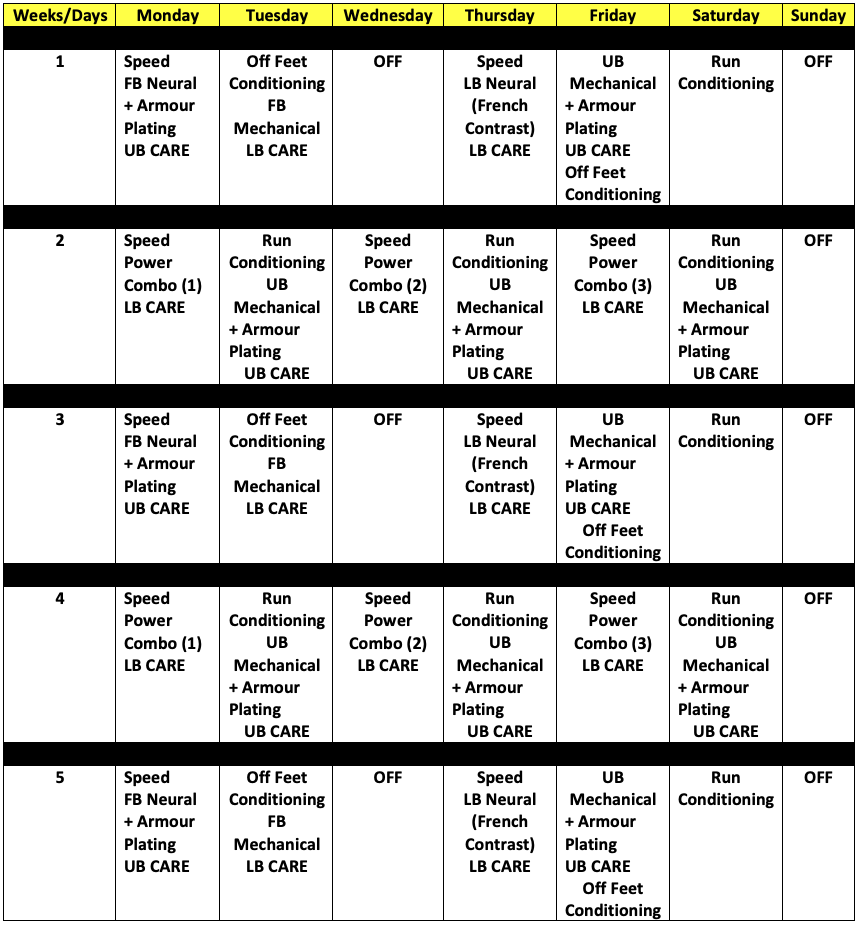
Alternate French Contrast Method each week:

Speed Power Combos Weeks 2 & 4
Program 1 (Monday) Lateral Speed Agility Focus
- Warm-up – Ladder patterns/Lateral Running drills
- Hang Split Power Snatch 8 sets x 3 reps
- Lateral resisted march/skip/run & release
- Hang Power Clean 6 sets x 4 reps
- Agility drills, Pro Agility, as per sheet
- Lateral Squat/Reverse Lunge into Step up with slosh bag 4 x 6
- Lateral plyometrics
- Monday: Heavy Olympic - Snatch, Clean or Pull + Single Leg super set Hinge movement/Knee movement
Program 2 (Wednesday) Power Acceleration Focus
- Warm-up – hurdle patterns with range of hurdle sizes, hops/jumps
- 3 position power snatch 8 sets
- Starts over 10 – 20 metres from a range of different starting positions
- Clean Pulls 6 sets x 4 reps
- Harness & Release sprints
- Jump Squats 4 x 6
- Sled Pulls & Prowler Pushes
- Wednesday: Heavy Squat - Front, Back or Box + Single Leg Hinge movement
Program 3 (Friday) Maximal Velocity Focus
- Warm-up – sprinters movement pattern warm-ups
- Med Ball Throws
- Plyos/Flying into Sprints
- Snatch Pulls 6 x 4
- In & Outs/Crossover Sprints
- Power Step Ups + Plyometrics (Box Jumps)
- 20m, 40m, 60m straight-line sprints
- Friday: Heavy Deadlift - Trap bar or regular + Single leg quad/knee dominant movement
Speed Program for weeks 1, 3 & 5

Conditioning Post Speed (Choose one for each session from below)

Solly Drill (apologies no picture) in 3s
Player A starts on the ground on the sideline, with a ball next to him. Player B starts with a hit shield on the 5m line. Player C holds a tackle bag on the 15m line. Player A gets up, picks the ball or med ball up, and staying low drives Player B (hit shield) back to 5 m line. He drops and long places the ball or med ball, gets up and sprints to Player C where he makes a tackle on a held tackle bag. He gets up and sprints back to the start. He keeps going for 45 seconds. There is 15 seconds for each payer to move forward one position. A goes to C, C to A, and B to A. 6 reps each.
Malcom Drill
A Malcolm drill, named after the legendary Great Britain rugby league player and coach, Malcolm Reilly, is a wonderful lactate tolerance drill as well as a drill to practice getting off the ground and back into position when fatigued. Start lying on the ground with your head behind the halfway line. Get up and backpedal to the 10 m line. Do a down and up then sprint through to the far 10 m line. Do a down and up and backpedal to the starting position down on the ground. This is one rep. A full set is six reps continuously to mimic the six tackles in rugby league.
Welsh Anaerobic Test
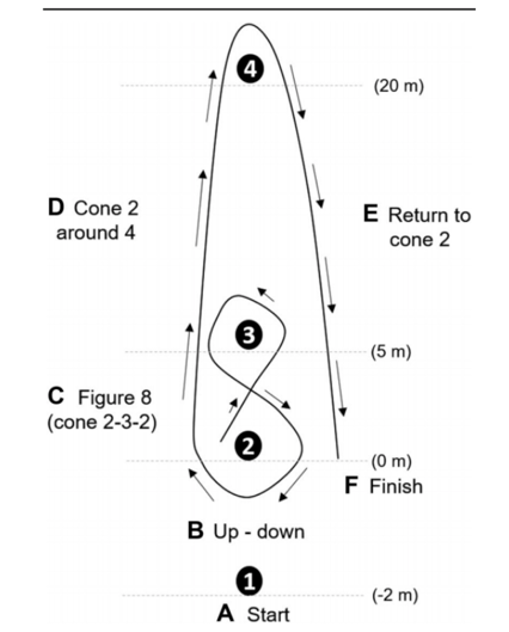
Phase IV
December 6 – December 24 (3 weeks)
Focus: Power & Strength + Speed & Metabolic Specific running + Contact Prep
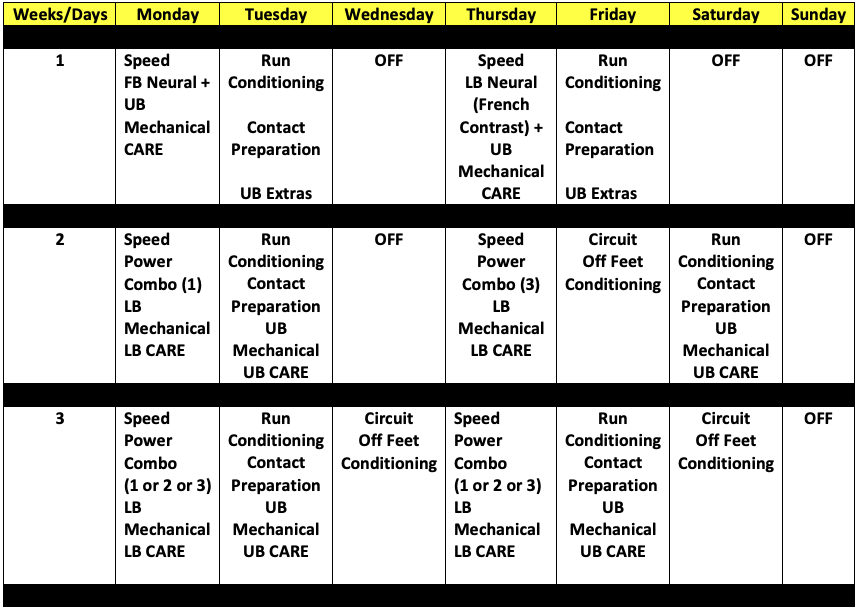
Examples of Training Sessions Contact/Combat Conditioning
Combat Conditioning Physical Preparation Session
Hindu Push-ups
Forward Neck Bridging (forward & back, side to side)
Commando Rolls in 3’s (outside man jumps over, middle man rolls)
Push-ups with hands-on heads in 3s
Get off the ground and into the athletic position
Unders & Overs
Chesting into standing wrestle
Forward rolls, backward rolls, shoulder rolls
Hand patterns through the short agility ladders with a rollout get up and sprint
Push-ups position arm slap
Chest to chest on the ground wrestle
Dragging wrestle, stop from commando crawling by holding onto waist
Animal movement patterns:
- Commando crawl
- Monkey walk
- Bear crawl
- Crab walk
- Alligator crawl
- Frog
A final point in regards to the full program is the week plan for the Active Rest weeks. Whilst the first two-week break following the last game of your season is a complete rest from all training, the remaining breaks are a change of pace weeks rather than complete rest weeks. During each of those one-week breaks from regular training, I recommend that you do something quite different for just two or three sessions in the week. This break from regular training is as much psychological and physiological so try and find an enjoyable fitness activity to stimulate you. You might like to try a CrossFit or tough mudder-type gym circuit program, some strongman challenges, some day hikes, or bike rides. Try and split the week up evenly so that you are doing some activity every second or third day. The key to this week is to have fun doing something different and just not park up on the sofa for a week binge-watching your favourite series on television. Also, be aware of your calorie intake as your energy output will be lower than normal for this week. Be ready to charge back into revitalized training for the next week.
Ashley Jones has worked in three professional sports across 30 years and four continents. He was awarded the NSCA's Professional Coach of the Year in 2016. Ashley holds his CSCS (Certified Strength and Conditioning Specialist) since 1988.










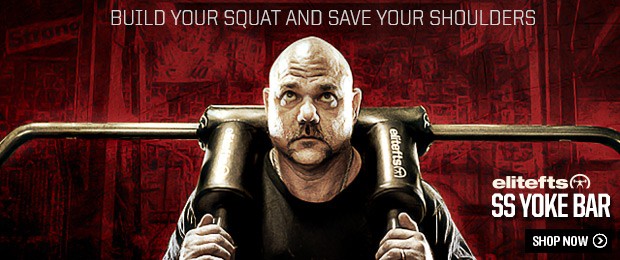
Learned a ton from you Ashley thank you for sharing again. Building body armour is super important for these collision athletes -- and I love the blending of their agility work with weightlifting or power movements.
Always more to learn!
Good Morning working up to a heavy 3RM or close to it
Single Leg RDL on a Landmine 3 sets x 8 - 12
Standing leg Curls with a Iron Boot 2 sets x 50+ reps
I hope that assists, ashley
Awesome info - could you help, i am a novice, doing a course through ASCA level 1, and given a shot at being the strength and conditioning coach for a small local country rugby club. As i am kicking off their training program next week, so a very short off season, am i best to start at a later phase or from phase 1 and cut the weeks back to two weeks for phase 1 and 2? Cheers
ashley@ashleyjonesstrengthcoach.com cheers, Ashley
For phase 1, i understand the sets/rep schemes for the bilateral/unilateral lower body work in day 1.
However what set/reps schemes would you advise for the upper body horizontal/vertical work listed for day 1, set out below?
1 x Upper Body Push (horizontal or vertical plane)
1 x Upper Body Pull (horizontal or vertical plane)
Cheers